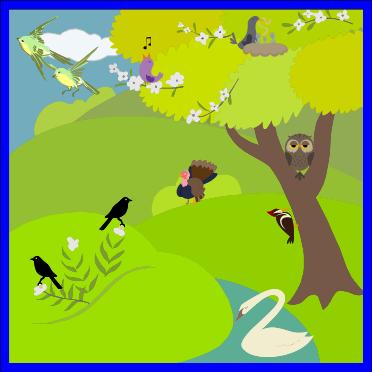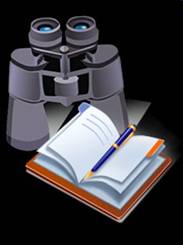Difference between revisions of "Field Ornithology"
| Line 6: | Line 6: | ||
<span style="font-size: x-large">EEB 3898: Field Methods in Ornithology | <span style="font-size: x-large">EEB 3898: Field Methods in Ornithology | ||
| − | '''Intensive Summer Session 1, June | + | '''Intensive Summer Session 1, June 7th - 25th, 2010''' '''MTWThF''' |
| − | Instructor: '''[mailto: | + | Instructor: '''[mailto:a.rico@uconn.edu Alejandro Rico]''' |
Office: Biol/Pharm 404 | Office: Biol/Pharm 404 | ||
| Line 16: | Line 16: | ||
Office hours: variable & flexible (call, email, drop by) | Office hours: variable & flexible (call, email, drop by) | ||
| − | |||
| − | |||
| − | |||
| − | |||
'''Course Objectives''' | '''Course Objectives''' | ||
| − | + | ➢ Acquire bird identification skills | |
| + | |||
| + | ➢ Learn how to take field notes | ||
| + | |||
| + | ➢ Learn and apply basic field research techniques, study design, and data analysis | ||
| − | + | ➢ Develop an individual project | |
| − | |||
| − | + | '''Tentative* schedule''' | |
{| border="1" cellpadding="2" | {| border="1" cellpadding="2" | ||
| Line 40: | Line 39: | ||
!style="background:" width="300"|Topic | !style="background:" width="300"|Topic | ||
|- | |- | ||
| − | | M | + | | M 07 || Course introduction and timeline; Bird identification (Optics, Guides and Notes) || M 14|| Capture/banding demonstration; Field notebooks (First Submission) |
| − | || M | + | || M 21 || Survey of coastal birds; Field notebooks (Final Submission) |
|- | |- | ||
| − | | T | + | | T 08 || Topography and Field Marks; Feet, Beaks and Body Form; Field exercises |
| − | || T | + | || T 15 || Individual project presentations; Paper submission (Introduction and Methods) |
| − | || T | + | || T 22 || Weather and Bird Movements; Individual project data analysis |
|- | |- | ||
| − | | W | + | | W 09 || Survey of local birds (Mansfield Hollow), start project thinking (written ideas) |
| − | || W | + | || W 16 || MIDTERM EXAM; birding after |
| − | || W | + | || W 23 || Individual project presentations and assisted work on the paper |
|- | |- | ||
| − | | Th | + | | Th 10 || Field research techniques, hypotheses testing, study design, and data analysis; {{pdf|http://hydrodictyon.eeb.uconn.edu/courses/fieldornithology/andersonetal.1979.pdf}}Anderson et al. 1979; {{pdf|http://hydrodictyon.eeb.uconn.edu/courses/fieldornithology/ortega%26capen1999.pdf}}Ortega & Cappen 1999 |
| − | || Th | + | || Th 17 || Individual project data collection I (Methods adjustment) |
| − | || Th | + | || Th 24 || Point count theory and field activity (use of eBird); PAPER SUBMISSION (FINAL) |
|- | |- | ||
| − | | F | + | | F 11 || Individual project guidelines and selection; Local birding |
| − | || F | + | || F 18 || Individual project data collection II (Final) |
| − | || F | + | || F 25 || FINAL EXAM; Instructor evaluations |
|- | |- | ||
</span> | </span> | ||
|} | |} | ||
| − | + | '''*''': Schedule is subject to change pending weather conditions, or unforeseen birding and research opportunities. | |
| + | |||
'''Course Materials''' | '''Course Materials''' | ||
| Line 73: | Line 73: | ||
'''• Required''' | '''• Required''' | ||
| − | o The Sibley Field Guide to the Birds of Eastern North America | + | o The Sibley Field Guide to the Birds of Eastern North America |
o Binoculars (available from us if you don’t have any) | o Binoculars (available from us if you don’t have any) | ||
| Line 81: | Line 81: | ||
'''• Recommended''' | '''• Recommended''' | ||
| − | o Sibley’s birding basics | + | o Sibley’s birding basics |
| − | o Birding by Ear: Eastern and Central North America | + | o Birding by Ear: Eastern and Central North America |
o Old shoes or hiking boots, & proper outdoor clothing (poison ivy, weather) | o Old shoes or hiking boots, & proper outdoor clothing (poison ivy, weather) | ||
| Line 92: | Line 92: | ||
| − | ''' | + | '''Grading''' |
| + | |||
| + | Exams: | ||
| + | June 16th (MIDTERM) [50 points]; | ||
| + | June 25th (FINAL) [50 points] | ||
| − | |||
| − | + | Individual Project Paper: | |
| + | June 15th (Intro and Methods) [30 points]; | ||
| + | June 24th (Final) [50 points] | ||
| − | |||
| − | + | Individual Project Presentations: | |
| − | [[ | + | June 15th (Intro and Methods) [20 points]; |
| − | + | June 24th (Final) [25 points] | |
| − | |||
| − | + | Field Notebook Submissions: | |
| − | + | June 14th (First) [20 points]; | |
| − | + | June 22nd (Final) [25 points] | |
| − | + | ||
| − | + | ||
| − | + | ||
| − | |||
| − | + | Field trips (5 points each): | |
| + | June 8th, 9th, 10th, 14th, 21st, 24th [30 points] | ||
| − | |||
| − | + | Total: [300 points] | |
| − | |||
Grading scale: A = 100-90%, B = 89-80%, C = 79-70%, D = 69-60%, F = 59-0%. | Grading scale: A = 100-90%, B = 89-80%, C = 79-70%, D = 69-60%, F = 59-0%. | ||
| − | Plus/minus system will be used for the final grade. | + | Plus/minus system will be used for the final grade. |
| Line 150: | Line 148: | ||
| + | '''Website design by Diego Sustaita''' | ||
[[Category:EEB Courses]] | [[Category:EEB Courses]] | ||
Revision as of 01:47, 7 June 2010
EEB 3898: Field Methods in Ornithology
Intensive Summer Session 1, June 7th - 25th, 2010 MTWThF
Instructor: Alejandro Rico
Office: Biol/Pharm 404
Phone: 860-486-0309
Office hours: variable & flexible (call, email, drop by)
Course Objectives
➢ Acquire bird identification skills
➢ Learn how to take field notes
➢ Learn and apply basic field research techniques, study design, and data analysis
➢ Develop an individual project
Tentative* schedule
*: Schedule is subject to change pending weather conditions, or unforeseen birding and research opportunities.
Course Materials
• Required
o The Sibley Field Guide to the Birds of Eastern North America
o Binoculars (available from us if you don’t have any)
o Field notepad/notebook
• Recommended
o Sibley’s birding basics
o Birding by Ear: Eastern and Central North America
o Old shoes or hiking boots, & proper outdoor clothing (poison ivy, weather)
o Insect repellent (ticks, mosquitoes)
o Sunscreen
Grading
Exams: June 16th (MIDTERM) [50 points]; June 25th (FINAL) [50 points]
Individual Project Paper:
June 15th (Intro and Methods) [30 points];
June 24th (Final) [50 points]
Individual Project Presentations:
June 15th (Intro and Methods) [20 points];
June 24th (Final) [25 points]
Field Notebook Submissions:
June 14th (First) [20 points];
June 22nd (Final) [25 points]
Field trips (5 points each):
June 8th, 9th, 10th, 14th, 21st, 24th [30 points]
Total: [300 points]
Grading scale: A = 100-90%, B = 89-80%, C = 79-70%, D = 69-60%, F = 59-0%.
Plus/minus system will be used for the final grade.
Additional References & Websites
• Bibby CJ, Burgess ND, Hill DA, Mustoe S, editors. 2000. Bird census techniques. San Diego, USA: Academic Press.
• Gill F. 2007. Ornithology. New York: W. H. Freeman and Company.
• Stiling P. 1999. Ecology: theories and application. New Jersey: Prentice Hall.
• Clark, G. A. 1999. Birds of Storrs, Connecticut and vicinity. 3rd Ed. Mansfield, CT: Natchaug Ornithological Society & Joshua’s Tract Conservation and Historic Trust.
• SORA (Searchable Ornithological Research Archive): http://elibrary.unm.edu/sora/index.php
• Cornell Lab of Ornithology “All About Birds”: http://www.birds.cornell.edu/AllAboutBirds
• Natchaug Ornithological Society: http://www.nosbird.org/ (esp. “local hotspots” http://www.nosbird.org/hotspots.html)
• Connecticut Ornithological Association: http://www.ctbirding.org/index.htm
• CT Audubon Society: http://www.ctaudubon.org/
• CT Department of Environmental Protection: http://www.ct.gov/dep/site/default.asp
Website design by Diego Sustaita

